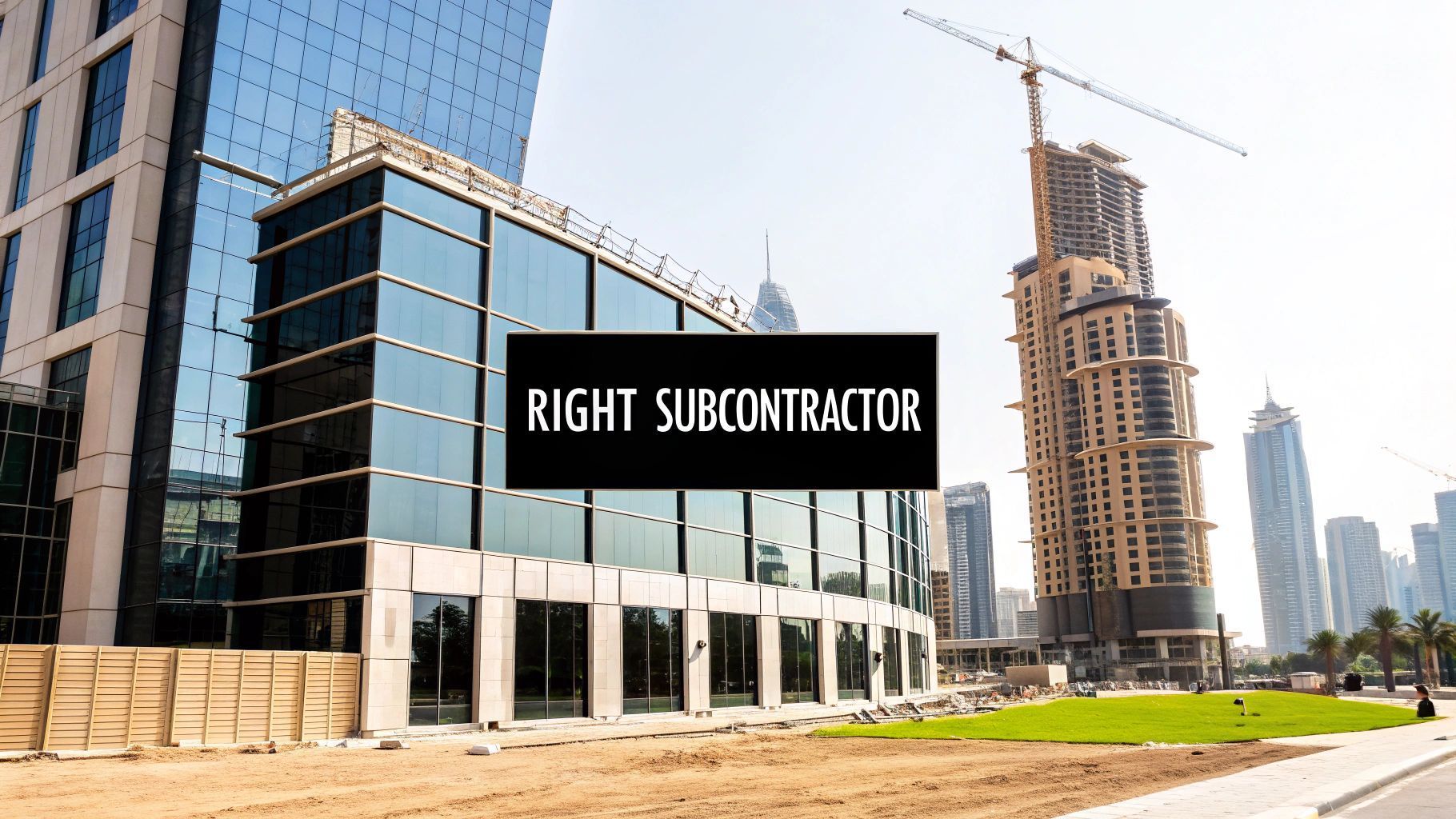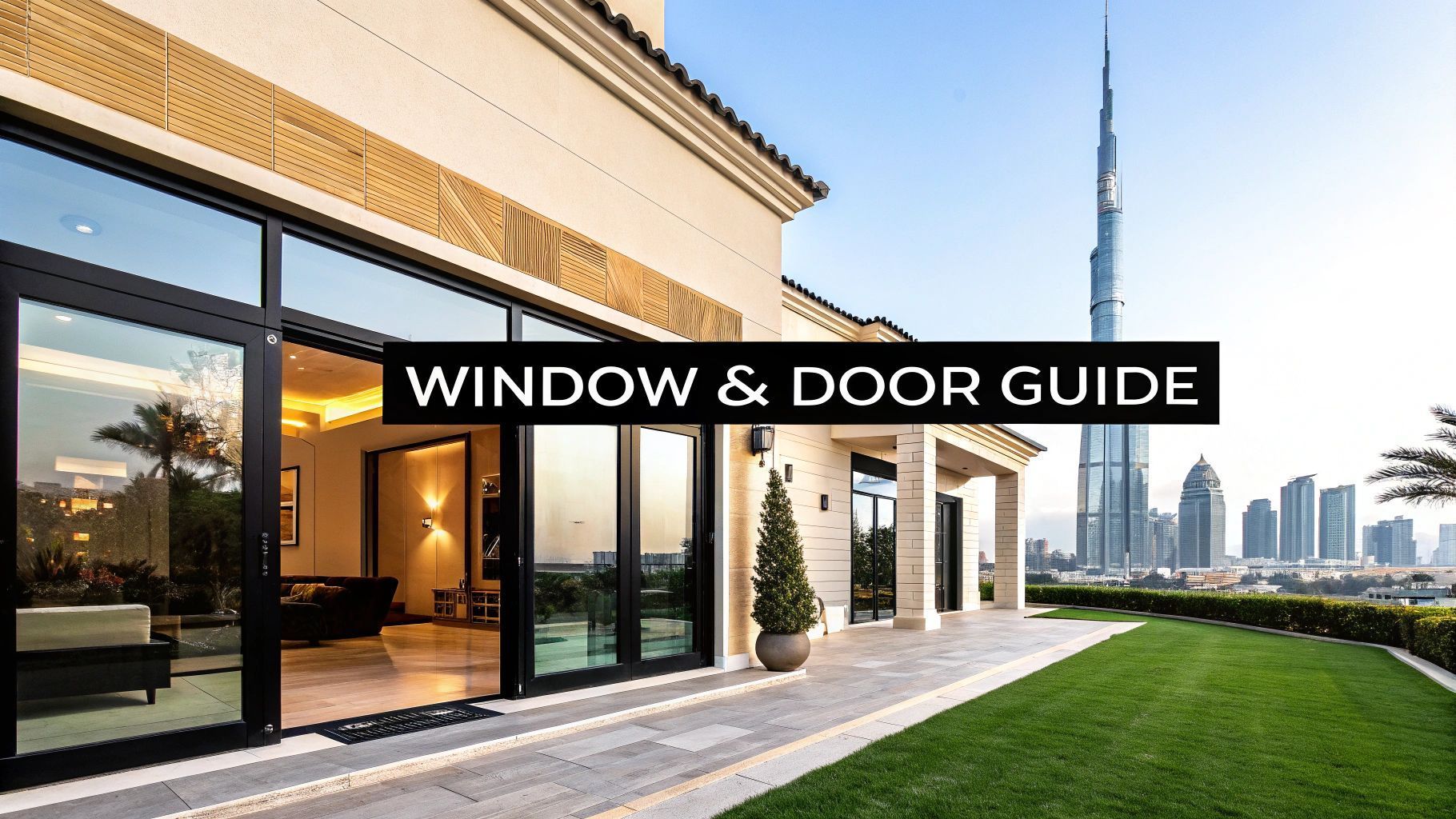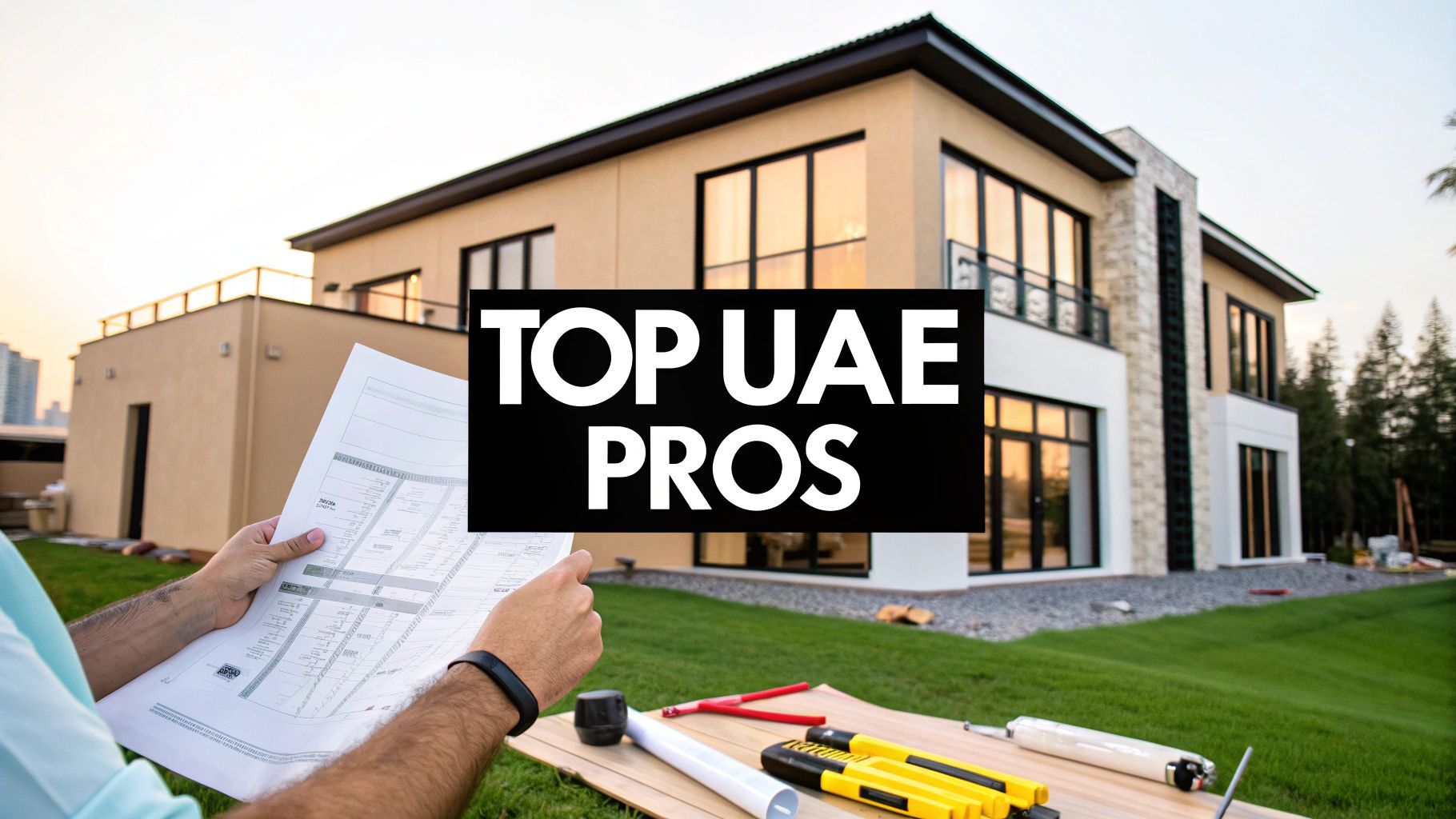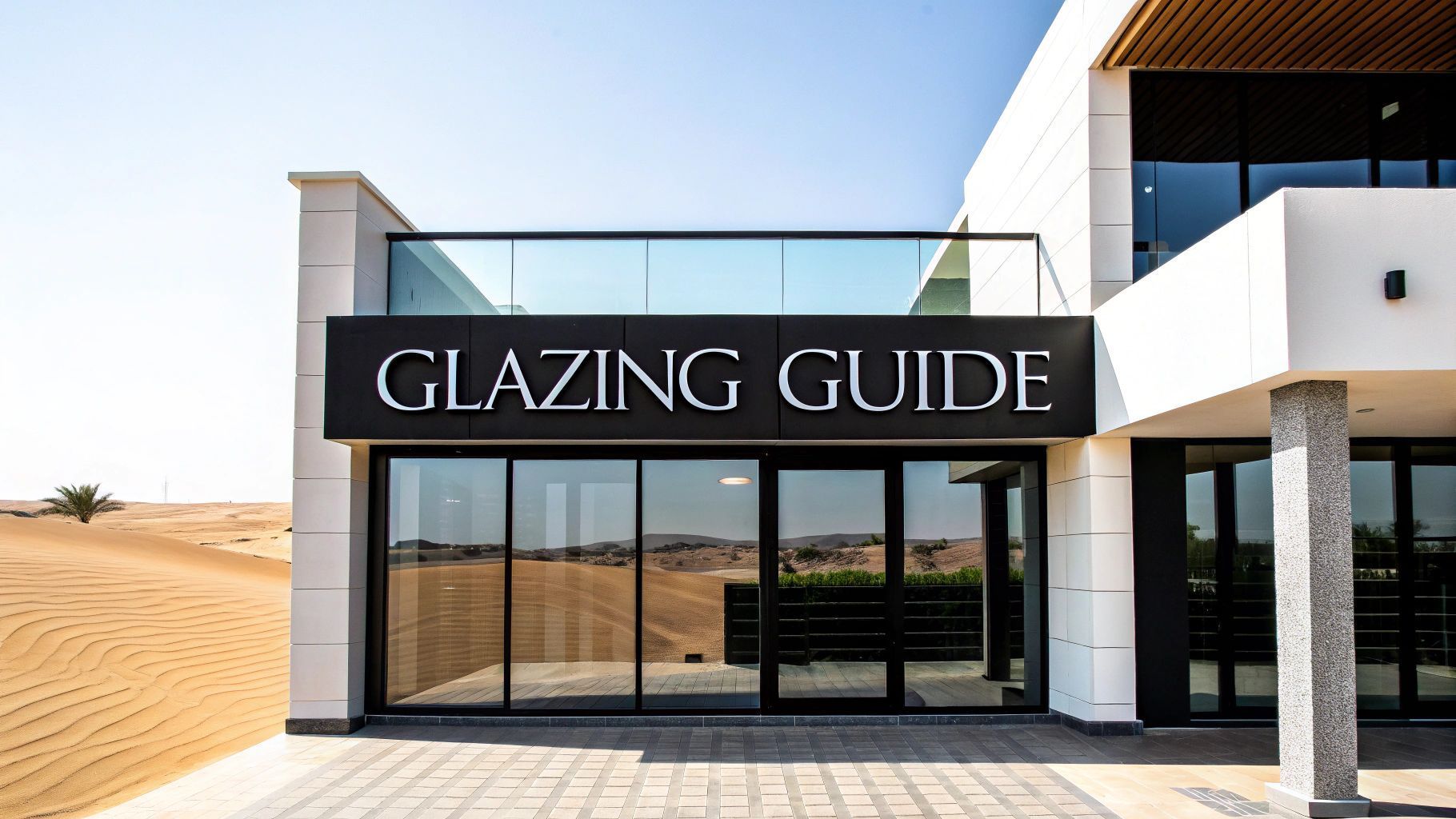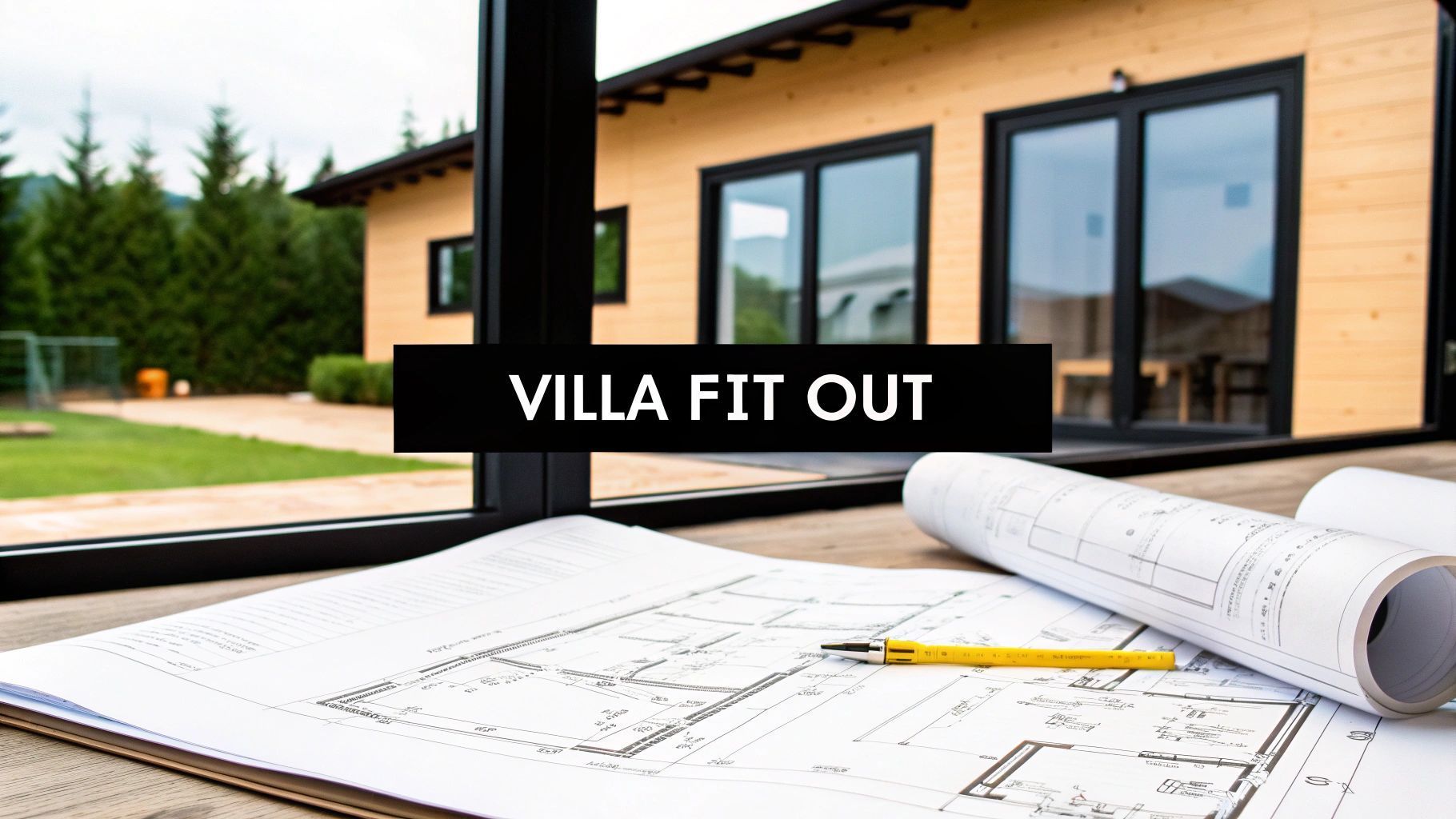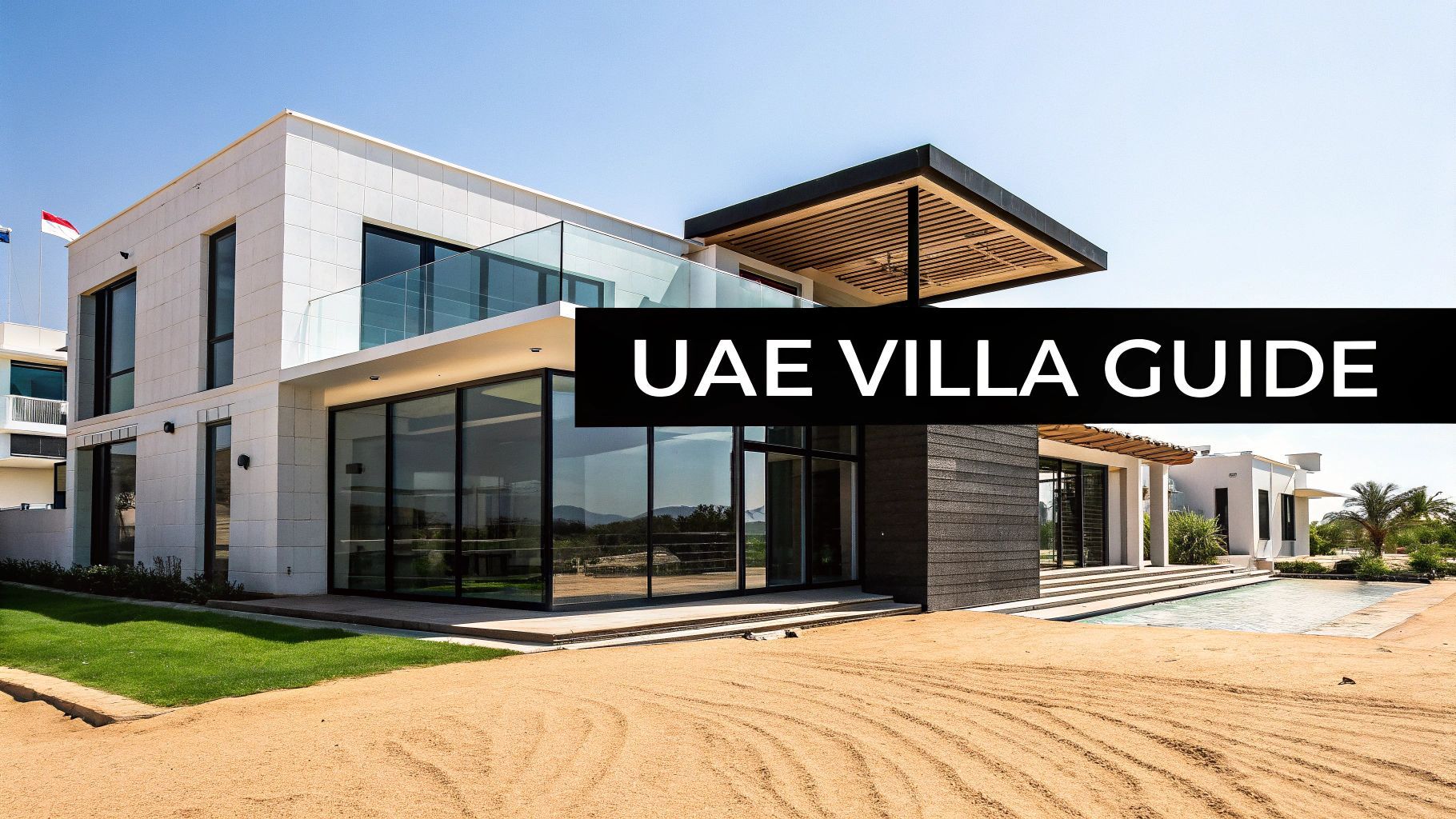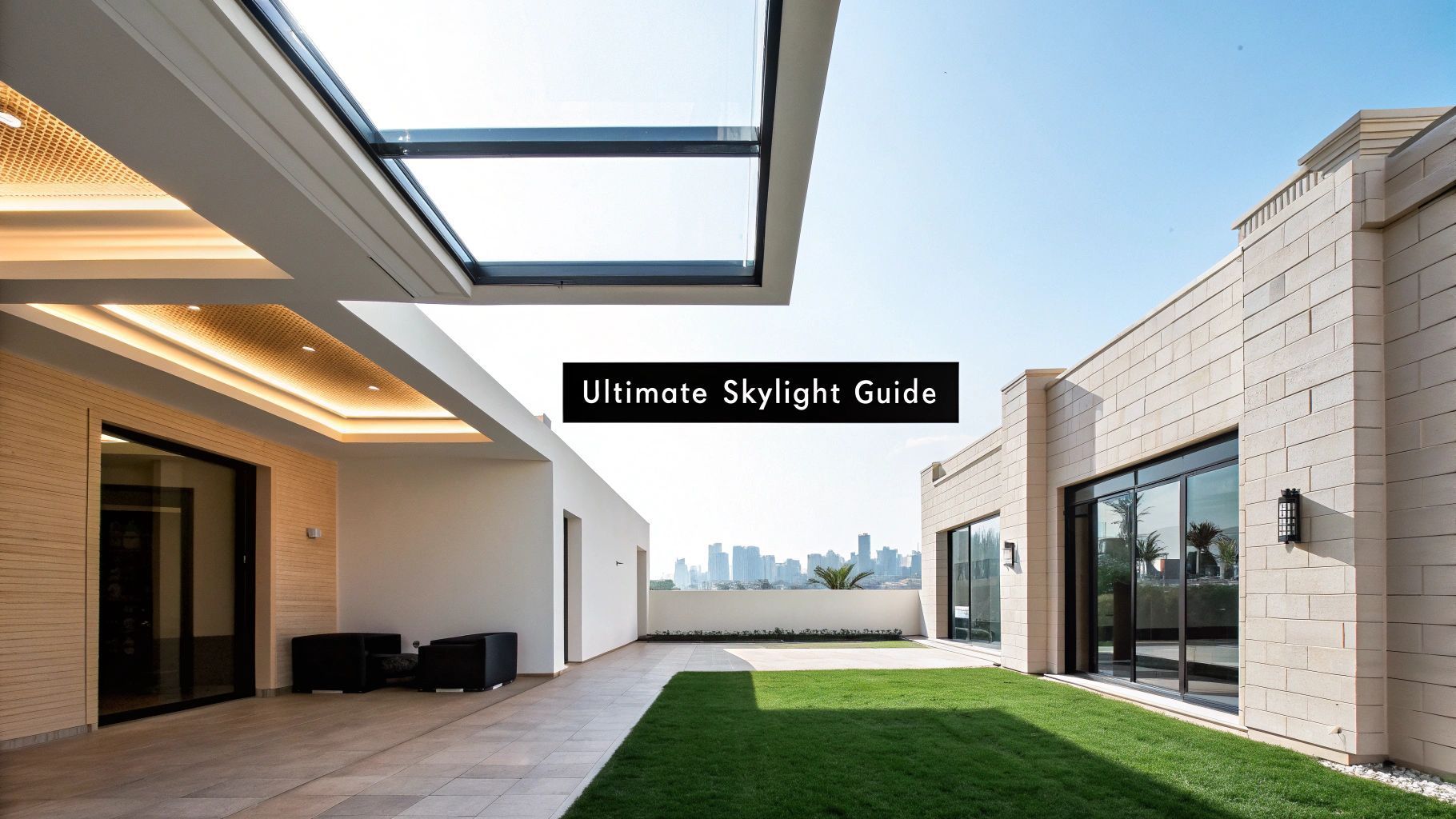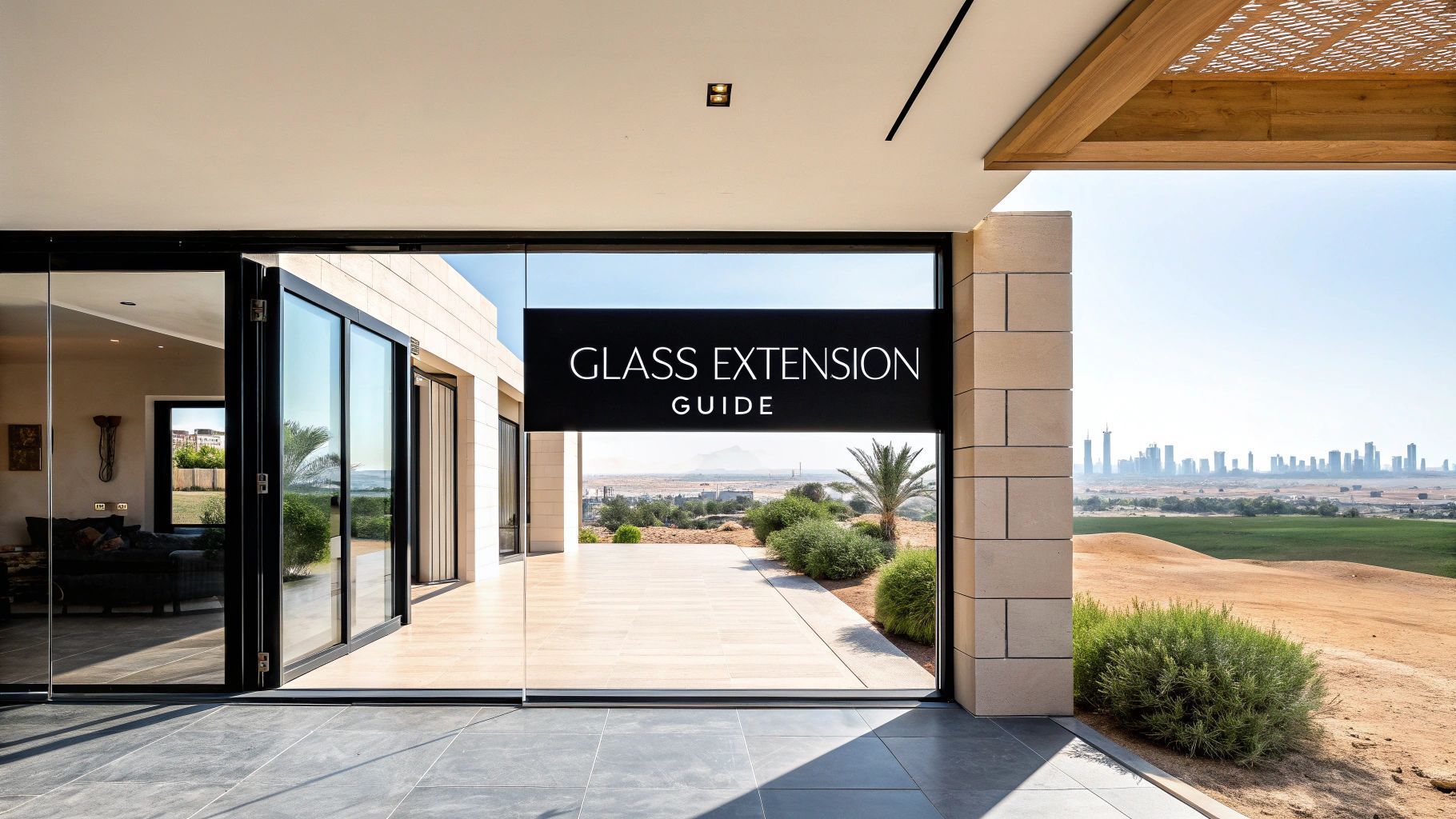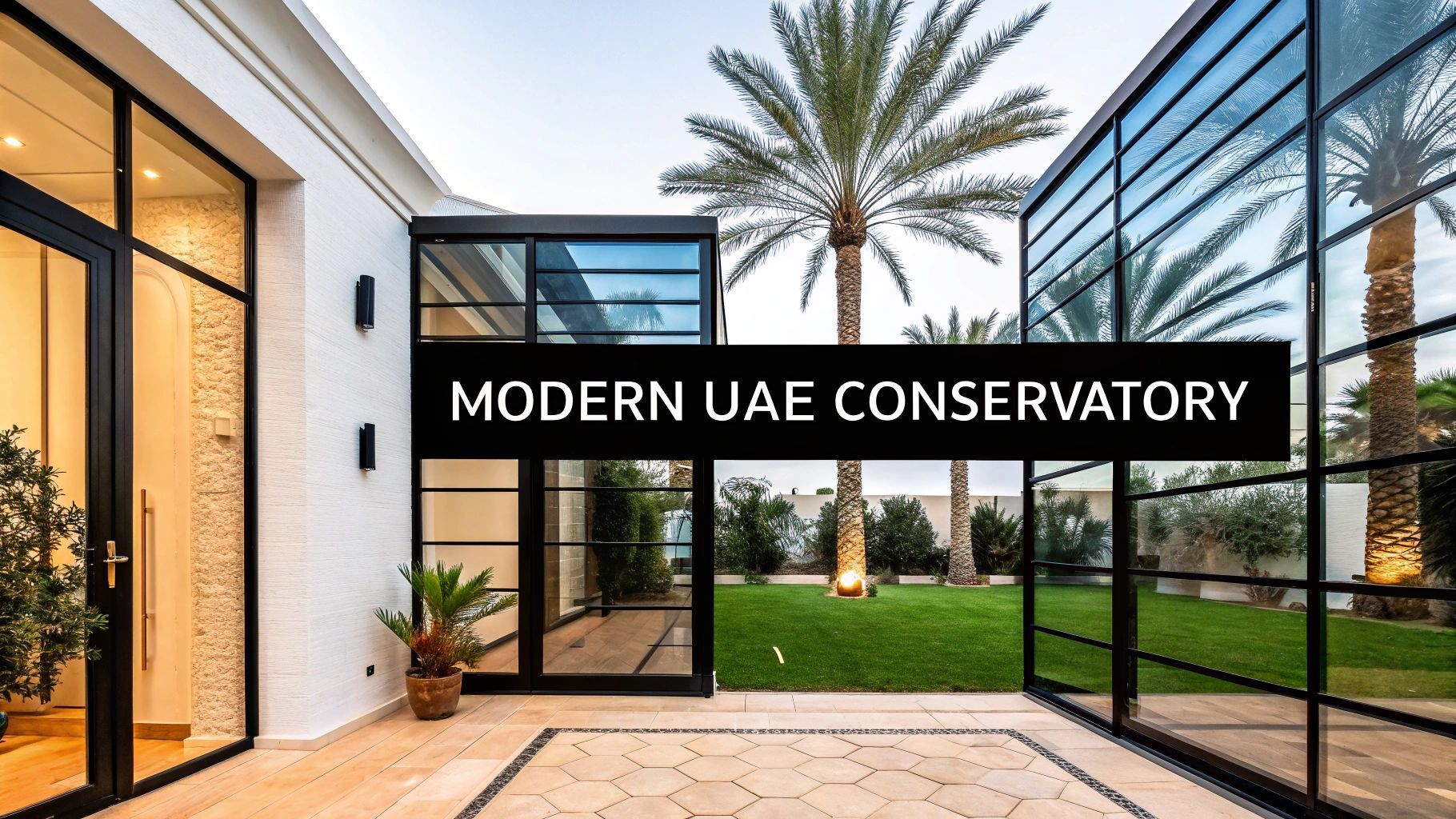Your Guide to a Perfect UAE Villa Extension
Your Guide to a Perfect UAE Villa Extension
Adding a room to your villa in the UAE is about more than just square footage—it's about enhancing your lifestyle and property value. A well-designed villa extension should serve a clear purpose, whether it’s a quiet home office, a sun-drenched living area, or a cool retreat for family gatherings.
Defining Your Ideal Villa Extension
Whether you’re in a dynamic community like Arabian Ranches or a luxury enclave on Palm Jumeirah, expanding your home starts with a clear vision. The goal is to create a space that perfectly fits your life while tackling the UAE's unique climate challenges, including intense heat, dust, and humidity.
A successful extension is measured by its function and comfort, not just its size. This is where premium materials make all the difference. Using high-performance systems like Cortizo aluminium or Vetromax glass elevates your property's value, floods your home with natural light, and creates a comfortable escape from the summer heat.
Identifying the Purpose of Your New Space
Before considering blueprints, you must define why you need more space. Is your family growing and in need of a playroom, or are you dreaming of a seamless indoor-outdoor entertainment area? Each goal dictates different design choices, materials, and budgets.
Common motivations for villa extensions in the UAE include:
- A dedicated home office: With remote work now common, a quiet, well-lit office is a top request. This demands excellent sound insulation and powerful, efficient climate control.
- An expanded living area: For those who love to host, an extension with an open-plan layout and large glass panels creates an airy, welcoming atmosphere perfect for social gatherings.
- A climate-controlled garden room: This provides the beauty of the outdoors without the blistering heat and humidity. Explore high-quality garden rooms and glass conservatories to see what’s possible.
- A modern majlis or guest suite: Creating a private, comfortable space for guests or traditional family gatherings remains a key priority for many villa owners in Dubai and Abu Dhabi.
\
Visualising the End Result
Once you know the purpose, you can visualise the design. How will the new space connect with the rest of your home? A kitchen extension in a Jumeirah villa, for instance, might feature large Vetro Slide doors that open directly onto a patio, creating the perfect setup for alfresco dining.
A great villa extension feels like it was always part of the original home, not an afterthought. It should seamlessly blend with the existing architecture while improving the overall flow and functionality of your living space.
Don't forget the practicalities. A ground-floor extension in Dubai that gets direct afternoon sun needs high-performance glazing—such as systems from Cortizo with a thermal break—to prevent it from overheating. Similarly, if your villa is near a busy road, specifying double-glazed units is essential for noise reduction. This detailed, practical thinking transforms a simple idea into a high-quality, genuinely useful addition to your home.
Mastering UAE Planning and Approvals
Expanding your villa is an exciting prospect, but the real work begins with navigating the required paperwork. Mastering the approvals process in the UAE is the most critical first step to avoid costly and frustrating delays down the line.
For any major renovation in Dubai or Abu Dhabi, you must compile a complete file of documents for submission. This is a strict requirement to ensure every project meets the UAE's high standards for safety, quality, and community aesthetics. Without these approvals, your project cannot legally proceed.
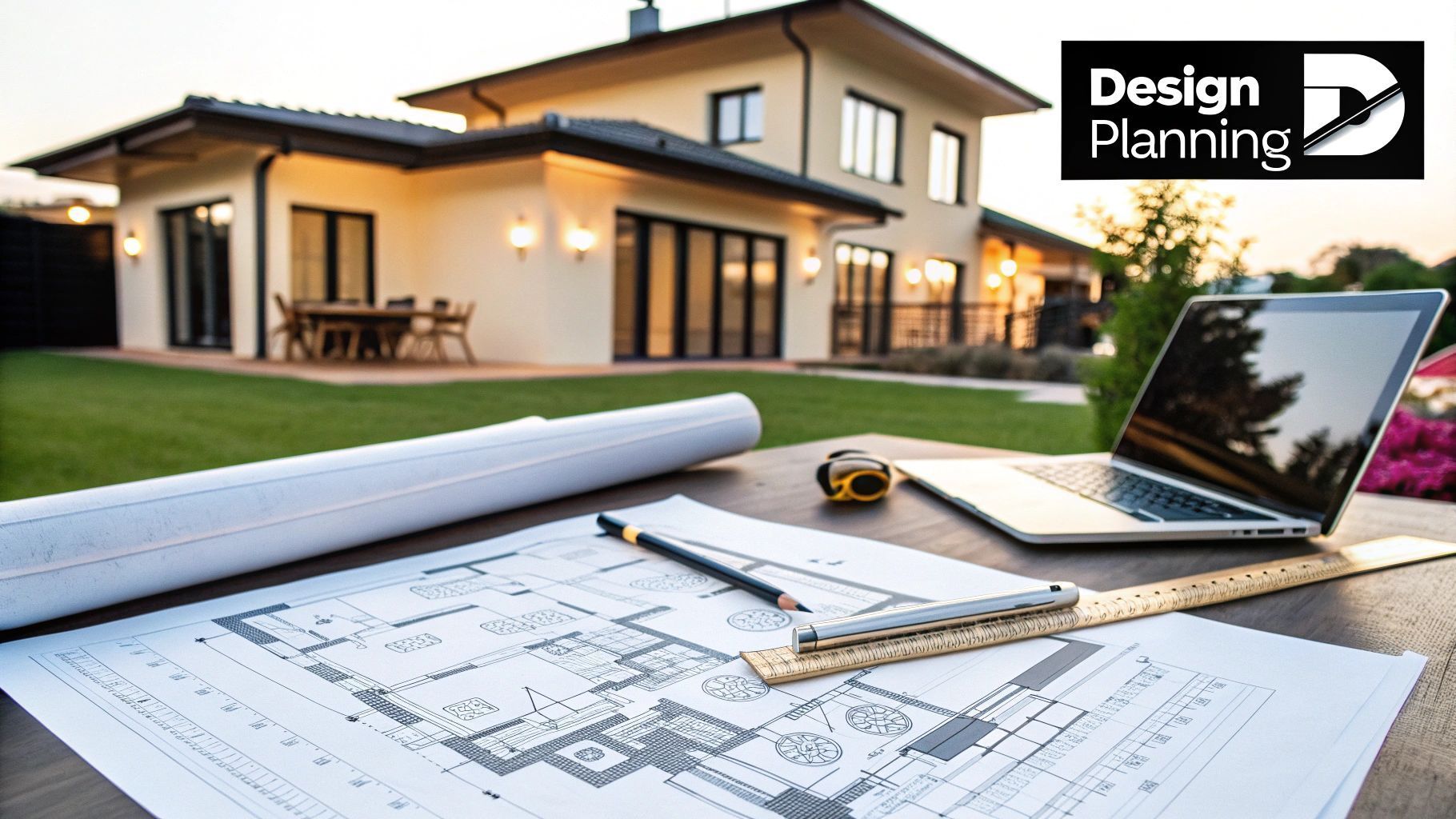
Key Documents for Your Submission
While specific requirements can vary slightly, the core package you need to submit is consistent across the Emirates. An experienced architect who regularly deals with these authorities is invaluable—they know precisely what is needed.
Your initial submission file will almost always include:
- Title Deed: Simple proof of property ownership.
- Detailed Architectural Drawings: Prepared by a licensed consultant, showing floor plans, elevations, and sections of your proposed extension.
- Structural Plans: Engineering drawings that detail foundations, columns, and beams to guarantee structural integrity.
- No Objection Certificate (NOC): This is the formal approval from your master developer, a critical and mandatory document.
Navigating Master Developer and Municipal Approvals
Obtaining the NOC is your first hurdle. If your villa is in a community like Arabian Ranches (developed by Emaar) or on Palm Jumeirah (Nakheel), you must secure their permission before approaching any government body. Each developer has its own aesthetic and structural guidelines to maintain community cohesion.
Once the developer’s NOC is secured, your complete file is submitted to the relevant municipal authority, such as Dubai Municipality or the Abu Dhabi Department of Municipalities and Transport. These bodies verify that your plans comply with official building codes, zoning laws, and safety regulations.
An experienced local architect is your greatest asset during the approvals phase. They understand the nuances of what each authority—from Emaar to Dubai Municipality—looks for, dramatically reducing the risk of rejection or requests for amendments.
Real-World Hurdles and How to Prepare
Several common roadblocks can arise during the approval process for a villa extension. One of the most frequent is the Gross Floor Area (GFA) or plot coverage ratio. This rule limits the total built-up area on your plot. In many established communities, villas are already near this limit, which can make a large extension challenging.
Zoning rules present another hurdle. Some communities have strict regulations on building height or how close your extension can be to the property line. A good architect will conduct a feasibility study early on to identify these potential constraints.
Finally, your design must respect the local climate. Municipalities are increasingly focused on sustainability. Plans incorporating energy-efficient systems—like thermally broken aluminium frames from Cortizo or high-performance uPVC from Deceuninck—are often viewed more favourably as they align with the UAE's Green Building codes.
Designing for the UAE Climate and Lifestyle
Adding an extension to your villa in the UAE is about creating a sanctuary from a demanding climate. Anyone living here understands the challenges: intense heat, pervasive dust, high humidity, and disruptive noise. A poorly designed extension can quickly become an unusable "greenhouse."
Smart design, however, turns these challenges into opportunities. The result is an extension that is cool, bright, and perfectly suited to the Emirates lifestyle.
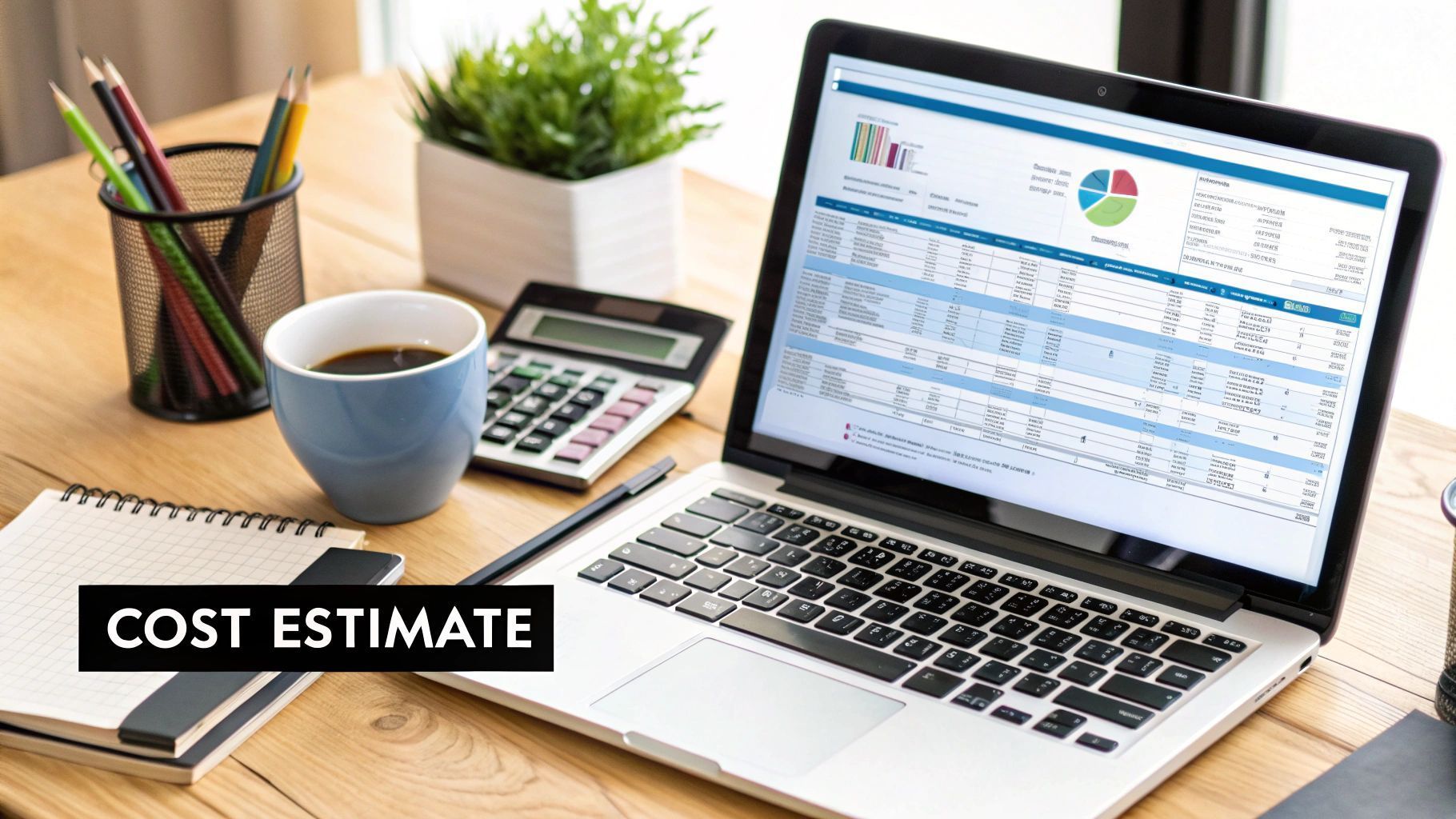
Strategic Orientation and Shading
Your first line of defence against the climate is controlling sun exposure. The orientation of your extension has a massive impact on its internal temperature and your energy bills. A south-facing extension will be exposed to direct sun all day, requiring powerful cooling to remain comfortable.
A north-facing orientation is ideal, as it receives gentle, indirect sunlight without the scorching heat. If that isn't possible, east or west-facing extensions can work but require significant external shading.
Effective shading solutions include:
- Overhangs and Pergolas: These architectural features block the high-angle summer sun before it hits the glass.
- Mashrabiya Screens: A modern take on traditional Arabic latticework provides filtered light while adding local character.
- Landscaping: Strategically planted trees and tall shrubs offer effective natural shade, especially for ground-floor extensions in communities like Arabian Ranches.
High-Performance Glazing and Insulation
Your choice of glass and framing is the most critical decision for any modern villa extension in the UAE. It is your primary defence against heat, dust, and noise. Standard single-pane glass is not a viable option, as it offers virtually no insulation.
For a comfortable and energy-efficient extension, thermally broken aluminium frames and double-glazed, Low-E coated glass are the absolute minimum standard. This combination is non-negotiable for preventing heat transfer and keeping cooled air inside.
Consider a sliding door system like Cortizo's Cor Vision Plus. It delivers incredible, floor-to-ceiling panoramic views while its thermal break technology acts as a powerful barrier against outdoor heat. Similarly, Deceuninck uPVC systems offer excellent insulation and are highly resistant to corrosion from the salt and humidity found in coastal areas like Palm Jumeirah.
Creating Climate-Controlled Lifestyle Spaces
A well-designed extension should enhance your lifestyle by providing a comfortable space for activities that are often impossible outdoors. The concept of a "winter garden" or a modern, enclosed majlis is perfectly suited for the UAE, offering a connection to the garden while remaining fully climate-controlled.
Imagine a tranquil reading nook that opens onto the garden with massive Vetro Slide doors. You achieve a seamless indoor-outdoor feeling without the oppressive heat.
Of course, effective climate control is paramount. A powerful, efficient air conditioning system is a necessity. When budgeting, it's vital to factor in the cost of ducted air conditioning installation, as integrating a new unit with your villa’s existing system requires professional planning.
Tackling Dust, Humidity, and Noise
Beyond the heat, your design must be resilient. Fine desert sand can penetrate the smallest gaps, while uncontrolled humidity can lead to condensation and mould.
Here’s how to build a resilient extension:
- Superior Sealing: High-quality gaskets and weather stripping on all windows and doors are crucial. Systems like Cortizo's Cor 70 are engineered with multiple sealing points to create an airtight barrier against dust and airborne sand.
- Ventilation Strategy: While an airtight seal is essential, controlled ventilation is key to managing humidity. This can be achieved through integrated systems or smart design for cross-ventilation during cooler months.
- Acoustic Insulation: If your villa is near a busy road, laminated or acoustic glass can be a game-changer. It dramatically reduces noise pollution, creating a peaceful interior.
Selecting High-Performance Materials and Systems
The long-term success of your villa extension depends on the quality of the materials you choose. In the UAE, this decision is about building a high-performance shield against intense heat, humidity, and dust—not just about aesthetics.
The right materials ensure your new space is comfortable, energy-efficient, and durable. The wrong choice can result in an expensive "greenhouse" that overloads your AC system. Your primary focus should be on the frames and glazing, which form the core of your extension's thermal envelope.
The planning stage alone shows how much is at stake.
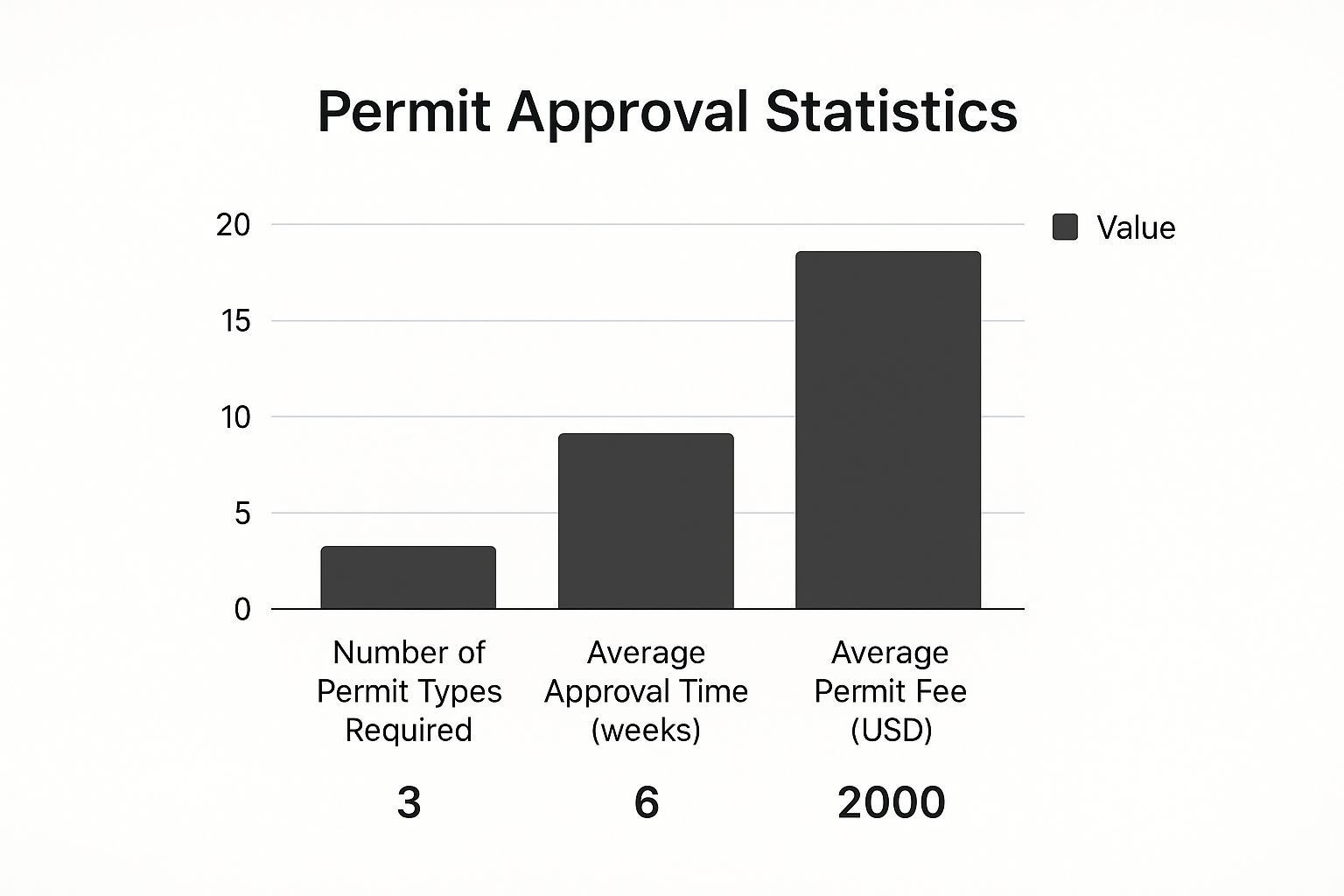
With an average of 3 permit types, a 6-week approval timeline, and fees around $2,000, you want to be certain the materials you specify justify the upfront investment.
Aluminium vs. uPVC Framing Systems
For high-end villas in the UAE, two materials stand out: thermally broken aluminium and high-grade uPVC. They both offer excellent performance but solve different challenges.
Thermally broken aluminium is the preferred choice for modern, minimalist designs. Standard aluminium is a good conductor of heat, which is a major drawback in our climate. The "thermal break"—a layer of non-conductive material integrated into the frame—physically stops this heat transfer.
This feature is critical for keeping your home cool. For expansive glass walls in communities like Palm Jumeirah or Emirates Hills, systems like Cortizo Cor Vision Plus deliver ultra-slim profiles without compromising thermal performance. You can explore the benefits of high-performance aluminium windows for UAE homes to see how they are engineered for our climate.
On the other hand, high-grade uPVC (unplasticised polyvinyl chloride) from brands like Deceuninck is a natural insulator, making it inherently energy-efficient. It is also completely resistant to corrosion from salt and humidity, a significant advantage for villas near the coast.
Material and System Comparison for UAE Villa Extensions
| System Type | Key Benefit | Best For | Recommended Product Example |
|---|---|---|---|
| Thermally Broken Aluminium | Slim profiles, maximum glass, modern look | Expansive sliding doors, floor-to-ceiling windows, and minimalist designs | Cortizo Cor Vision Plus |
| High-Performance uPVC | Superior thermal & sound insulation | Energy-conscious homes, areas with high humidity, or traditional aesthetics | Deceuninck Legend System |
| Aluminium Bifold Doors | Seamless indoor-outdoor connection | Patios, garden rooms, and entertainment areas | Cortizo Bifold System |
| Laminated Safety Glass | Enhanced security and safety (shatterproof) | Ground-floor extensions, large accessible doors, and homes with children | Vetro Slide with Laminated Glazing |
The choice between aluminium and uPVC often depends on the architectural vision and specific performance requirements of your extension.
The Critical Role of High-Performance Glass
The frame is only half the battle; the glass is just as important. In the UAE, single glazing is inadequate for our climate. The absolute minimum should be a double-glazed unit with a specialised coating.
A double-glazed unit consists of two panes of glass separated by a sealed gap filled with air or an inert gas like argon. This gap acts as a powerful insulator, reducing heat transfer and providing excellent soundproofing.
To truly combat the heat, you need glass with a low-emissivity (Low-E) coating. This invisible, microscopic metal layer reflects long-wave infrared heat. In summer, it reflects the sun's heat away from your extension. In winter, it reflects your home's internal heat back into the room.
For ground-floor extensions with large sliding doors like the Vetro Slide system, we always recommend laminated glass for security. It is made of two glass panes bonded with a polymer interlayer. If the glass breaks, the fragments stick to the interlayer instead of shattering, providing huge peace of mind.
Managing Construction and Final Touches
With your designs approved and materials selected, your project moves from blueprint to reality. This is the most exciting phase, but it requires careful management to stay on track, on time, and on budget.
The most important decision you'll make now is choosing the right contractor. You need a qualified team with a proven portfolio of UAE villa extensions. They will be familiar with local challenges, from navigating worksite rules in communities like Arabian Ranches to implementing effective dust control measures during a shamal.
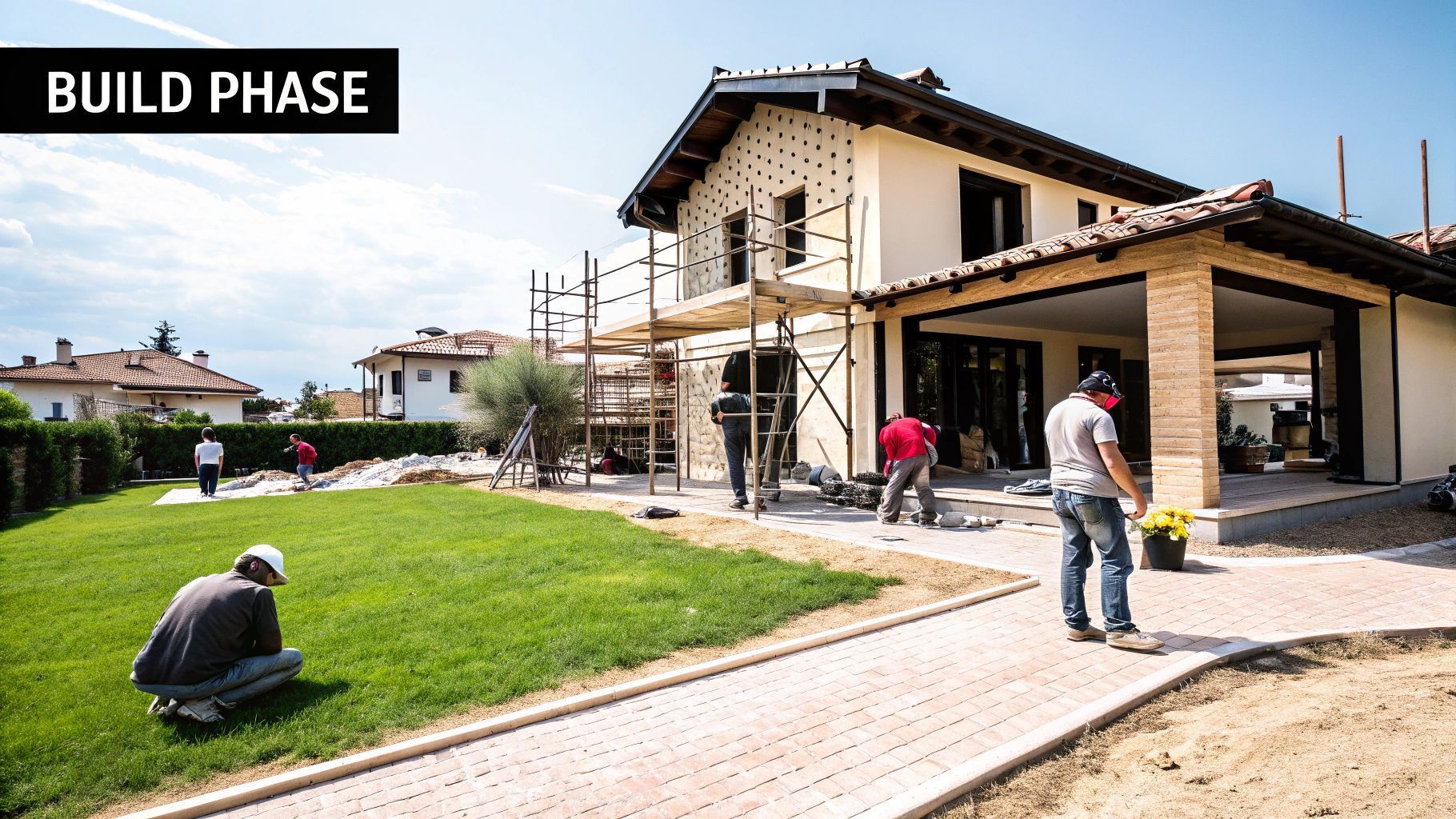
Working With Your Contractor
Your relationship with your contractor is crucial. You need a partner who is skilled and an excellent communicator. Before signing a contract, be sure to cover the essential questions to ask a general contractor to ensure everyone is aligned from day one.
Regular site meetings are non-negotiable. Weekly check-ins with the project manager to review progress against the schedule and address any issues are highly recommended. For more on managing a project, our guide to a smart villa renovation in the UAE is a great resource.
A good working relationship with your contractor is fundamental. Trust their expertise, but never be afraid to ask questions. The best project managers welcome your input and see it as a team effort to get the best result.
Demand for high-quality living spaces in the UAE is strong. The residential construction market is expanding, with high-end villa extensions and renovations making up a significant portion of projects in cities like Dubai and Abu Dhabi.
Key Construction Milestones
Every project is unique, but the construction of your extension will generally follow a predictable sequence. Understanding these key stages helps you track progress.
- Foundations and Substructure: This involves preparing the ground and pouring the concrete foundations, which form the base for the entire structure.
- Superstructure and Shell: The frame, walls, and roof are constructed, giving your extension its recognisable shape.
- Weatherproofing and Glazing: High-performance systems like your Cortizo windows or Vetro Slide doors are installed, making the shell watertight and sealed from the elements.
- First Fix (MEP): This is the installation of hidden mechanical, electrical, and plumbing systems, including wiring and AC ducting.
- Finishing Touches: The aesthetic vision comes to life with plastering, flooring, painting, and fitting lights and fixtures, transforming the site into a beautiful living space.
Once work is complete, a final walkthrough with your contractor is conducted to create a "snagging list" of any minor fixes. After these are addressed, your new villa extension is ready to enjoy.
Common Questions About Villa Extensions
Embarking on a villa extension is a major decision, and it’s natural to have questions. We’ve compiled answers to the most common queries from homeowners across Dubai, Abu Dhabi, and the rest of the UAE to provide clear, practical guidance.
How Long Does a Villa Extension Take in Dubai?
A high-quality villa extension in Dubai typically takes 4 to 8 months from initial design to final handover. The "pre-construction" phase—which includes design, engineering, and securing approvals from master developers like Emaar or Nakheel—can take 1 to 3 months alone.
Once approved, the actual construction for a standard ground-floor extension usually takes another 3 to 5 months. This timeline can extend if your project involves complex structural work or custom materials, such as bespoke Cortizo sliding doors. It's always wise to build a buffer into your schedule.
What Features Matter Most for UAE Windows and Doors?
In the UAE's climate, three features are non-negotiable for windows and doors: thermal insulation, dust proofing, and sound reduction.
First, look for frames with a 'thermal break'. This is a strip of non-conductive material separating the inner and outer metal frames, which is essential in premium aluminium systems like the Cortizo Cor 70. It physically stops heat from entering your home, significantly reducing your AC costs.
Next, the glass itself should be double-glazed with a Low-E (low-emissivity) coating as a minimum standard. The two panes create an insulating air pocket, while the invisible Low-E coating reflects the sun's heat back outside.
Finally, high-quality seals and gaskets are crucial. They create a tight barrier that keeps out fine desert sand and muffles noise from traffic or nearby construction.
Can I Build an Extension on Any Villa?
Not always. The feasibility of an extension depends on your community's rules and your plot's Gross Floor Area (GFA) ratio. This regulation limits the total built-up area on your land to prevent overdevelopment.
In established communities like Arabian Ranches or Emirates Hills, many villas are already near their GFA limit. Your first step should be to obtain a No Objection Certificate (NOC) from your master developer, who will confirm how much, if any, buildable area you have available.
An experienced architect or a specialist contractor can do a quick feasibility check on your property. This preliminary review confirms your GFA allowance and spots any other potential roadblocks before you invest serious time and money into the design.
What Is the Average Cost for a High-Quality Extension?
A precise cost is difficult to provide, as every project is unique. However, for a premium villa extension in the UAE, a realistic budget is between AED 3,000 and AED 5,500 per square metre.
The final cost depends on the project's complexity and specifications. A well-built extension using standard, high-quality materials will be at the lower end of this range. A high-end space featuring luxury systems like Cor Vision Plus sliding doors, acoustic glazing, and custom finishes will be at the top end.
To get an accurate figure, obtain detailed, itemised quotes from several reputable contractors. A comprehensive quote should break down all costs, from the brand of aluminium to the final paint finish, to avoid any surprises.
If you're planning a renovation or villa upgrade in the UAE, Swift Rooms can help you specify the best window and door system for your project. Contact us today for a quote or consultation.
